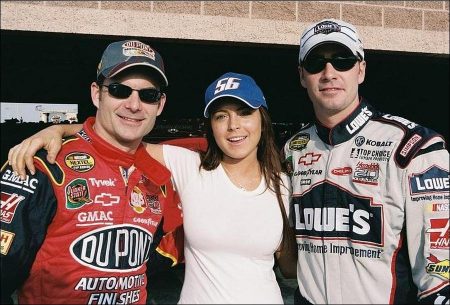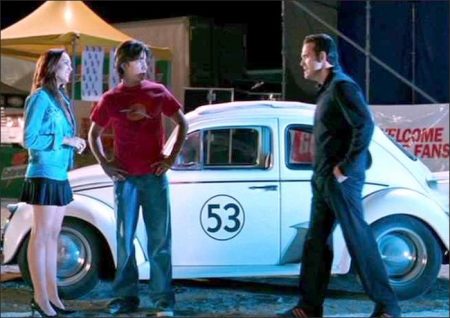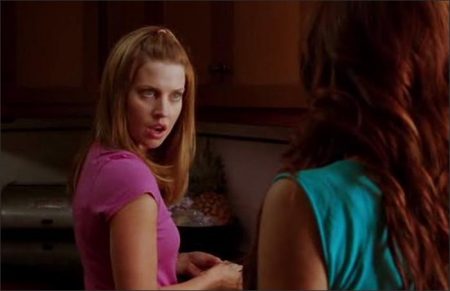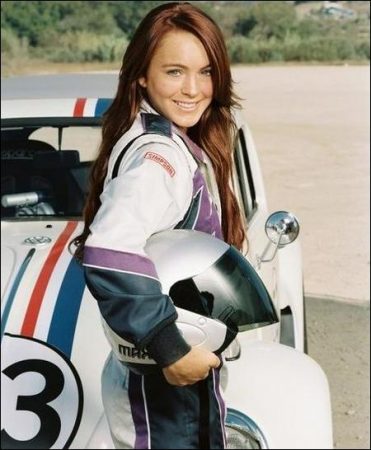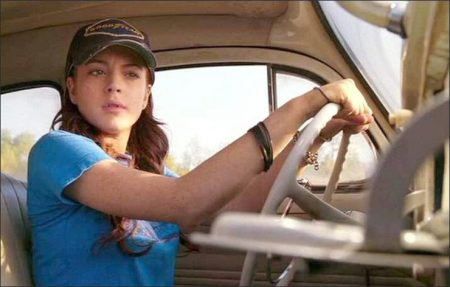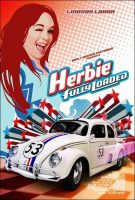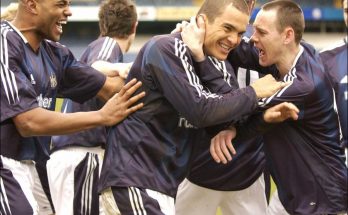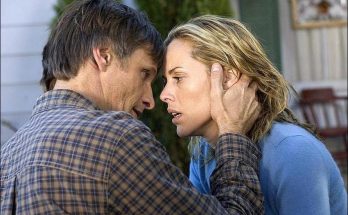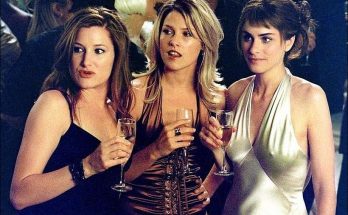Qualifying Lap: Herbie Is Resurrected and Rides Again
It was 1969 when America first discovered Herbie, AKA “The Love Bug,” the incredible little car with the body of a Beetle and the heart of a champion who came vividly to life in the runaway hit family movie of that era. The tale of the happy-go-lucky Volkswagen Beetle with a pepped-up personality and a need for speed, set against the groovy, love-is-in-the-air backdrop of ’60s San Francisco, became instantly popular with audiences of all ages. The film would go on to spawn three more spin-off features and several television shows.
More than three decades later, the producers of Herbie: Fully Loaded realized that many of those who grew up with Herbie in the’60s, ’70s and ’80s now have kids of their own, and that they too might be ready for a new adventure involving the world’s first thinking, feeling, match-making automobile just for them. The idea was to keep Herbie’s retro-cool while bringing him roaring into the 21st century…as a NASCAR racer.
Says producer Robert Simonds: “There was little doubt in our minds that if Herbie was coming out of retirement in 2005, he’d want to head straight for the most exciting racing arena in America today: NASCAR. We were especially grateful to have the cooperation and participation of NASCAR as we began to develop the project. The result is that while this Herbie is as playful and fun as ever, he has to truly rev it up to take on the world of today’s real race champs.”
The officials at NASCAR were equally enthusiastic about joining forces with the world’s most famous magical car. “For NASCAR, it was a perfect fit,” says Sarah Nettinga, director of film, television and music entertainment for NASCAR. “People all over the world know Herbie, and when you say ‘Herbie the Love Bug meets NASCAR,’ you know immediately what’s going to happen: all kinds of fantastic things are about to ensue on the track. I also think NASCAR fans and Herbie share a lot of the same values of being family-friendly, genuine, down-to-earth and fun-loving. Herbie’s great in the NASCAR arena because he is a complete underdog—and anyone who has watched NASCAR knows that part of its excitement is that it’s a place where the underdog always has a shot at moving up from the back of the pack to win.”
Nettinga continues: “One thing that was really interesting was the NASCAR drivers’ reaction to doing a Herbie movie—they all immediately wanted to be involved! So you have Jimmie Johnson, Jeff Gordon, Kevin Harvick, Jamie McMurray, Casey Mears, Rusty Wallace and Dale Jarrett all racing against Herbie. They all felt an amazing affection for Herbie, and I think it was truly exciting for them to be a part of this movie.”
When the script for Herbie: Fully Loaded crossed paths with rising director Angela Robinson, she also felt a spark. She was herself a Herbie fan since childhood, but even more than that, Robinson loved the screenplay’s empowering theme of a young woman pursuing her wildest dreams against the odds.
“I thought the writers had found an amazing new angle to make Herbie very fresh for today’s audiences by creating this spirited young woman who wants to be a NASCAR driver, and who also becomes the only person who can help Herbie get back to the racetrack and fulfill his destiny,” she says. “The story had a great combination of bigaction racing scenes that I loved, along with the humor that comes with Herbie, and then this uplifting story of a woman trying to prove herself in the vibrant, dynamic but usually male-dominated world of NASCAR. That great mix attracted me to the project.”
The producers, in turn, were pleased by Robinson’s dynamically contemporary approach. “Angela has this really great pop sensibility and a very clever sense of humor—which is what the original Herbie had in spades—so we felt she was the right person to bring the story speeding into 2005,” says co-producer Lisa Stewart.
From the beginning, the filmmakers especially wanted to make sure that this new film would combine a respect for Herbie’s past with innovative ideas for how to take the effervescent VW into a much more high-tech future.
“Herbie is a character who has really become part of the fabric of the culture,” says executive producer Michael Fottrell. “We all still know about him—grandparents know about him, parents know about him and even kids today already know who he is. So it seemed time to bring this great iconic character into the new millennium.”
Continues executive producer Charles Hirschhorn: “We ultimately designed 36 different versions of Herbie for the film, from Junkyard Herbie to Demolition Derby Herbie to Street Racer Herbie to NASCAR Herbie. We have Herbies in every shape, size and personality, but he has always had that same can-do, love-makes-the-world-go-round attitude that makes him such a lovable and enduring fairy-tale character.”
Angela Robinson was especially devoted to keeping Herbie’s history alive while, at the same time, bringing him into the 21st century. “I went back through all the Herbie movies, television shows and web sites to make sure we got every detail right even as we were updating Herbie, because Herbie’s a character people feel like they know and I wanted to stay absolutely true to that,” she says. “From the beginning, I didn’t want to rely entirely just on computers to generate Herbie, because he’s a character that needs to be real. So we used actual ’60s-era VWs enhanced with lots of advanced robotics and digital aftereffects. In fact, Herbie became so real to us on the set that, at times, I was tempted to direct him just like an actor—I’d say, ‘Herbie, move left!’”
Pace Lap: Casting Herbie’s Human Race Team
Maggie Peyton – A Young Woman Thirsting for a Chance to Race
Herbie’s mission in life has always been to find a race-car driver who could work with him as a true friend, hand to wheel, as they zoomed their way to the very top. In Herbie: Fully Loaded, he finds that friend in a most unlikely person: a new college graduate who comes to the trash heap where Herbie has been discarded, hoping to find a sports car. As it turns out, Herbie is in luck, because that college graduate also happens to be Maggie Peyton, heir to a NASCAR legacy and a young woman thirsting for a chance to race…even in a rusty-but-wily ’60s VW that no one believes has a chance!
Looking to find a young actress with the charisma, guts and comic panache to play Maggie Peyton, the filmmakers approached popular teen star Lindsay Lohan, their top choice. “I was incredibly excited to work with Lindsay because I had been blown away by her energy, timing and screen presence in her previous films,” states director Angela Robinson. “She perfectly embodied all the characteristics needed for Maggie. Lindsay has the sensitivity to draw you into the emotion of the family story, while also being tough enough that you can really believe her as a fearless race-car driver and fun enough to add comic sparkle to the film. It was a total pleasure to work with her.
Lindsay already knew about the legend of “Herbie the Love Bug” and was raring to go. “I had seen the original movie, and I loved that it’s the kind of story that gets passed down from one generation to the next,” she says. “There’s something about Herbie that is so magical and special, you really care about him as a kind of person, and it’s hard to even think about him as just a car! I also thought it would be really cool to do a movie that appeals to kids as well as to all those adults who grew up with Herbie. And to get to learn to race cars on top of all that was just too awesome to resist.”
Lindsay especially related to Maggie Peyton’s indomitable spirit and attitude of trying to live life to the fullest. “She’s a great character—a tomboy with a kind of surfer vibe, who has fulfilled her need for speed doing all kinds of tricks on her skateboard,” explains Lohan. “Still, she has this feeling that she has the talent to be a great racer, even if her dad is too worried about her to let her go out on the track. Somewhere inside her she just knows she has to go after her dreams—and Herbie takes her there. He even learns a thing or two about skateboarding!”
Though she found the entire production to be full of fun and good vibes, perhaps Lindsay’s absolute favorite part of Herbie: Fully Loaded was getting to slide behind the wheel and enter the thrilling world of NASCAR…as an insider. “It was just amazing,” she says. “We even got to go out to a NASCAR race in Fontana and race Herbie on the track! We were there with Jeff Gordon and Dale Earnhardt Jr., and all the stars and the cheering fans, and they even announced my name as one of the drivers. It was so cool. It was a once-in-a-lifetime experience.”
Maggie Peyton isn’t the only human being who gets wrapped up in Herbie’s adventurous dreams of auto racing. Among the other characters that come along for the ride are:
Kevin—The Street-Savvy Mechanic Who Revs Herbie Back Up
Maggie Peyton’s adventures with Herbie accelerate when they wind up at an out-ofthe-way garage where Maggie meets up with Kevin, an old high-school friend who has transformed into an ace urban mechanic who can work modern miracles on vintage cars. It is Kevin who ultimately patches Herbie up and transforms him into a tricked-out, sassy street racer—winning both Maggie’s and Herbie’s affection along the way.
To play Kevin, the filmmakers looked for someone who could fuel Maggie Peyton’s spirit with comedy. They found what they were looking for in Justin Long, a young comic star who was most recently seen with Ben Stiller in the hit “Dodgeball.” “Justin is a very talented actor and comedian who brings a lot of comic relief to the story,” says Angela Robinson. “He was a great match for Lindsay as Maggie Peyton’s love interest.”
Long was thrilled to become Herbie’s wrench-wielding savior. “What’s not to love about Herbie? He possesses magical gifts, a big heart, and he’s always bringing people together and showing them the potential for friendship and romance,” Long notes. “And Kevin is the one person who really sees the potential under Herbie’s hood. I love that part of the story—it’s a great metaphor for seeing the beauty and magic inside an ugly duckling.”
Justin had to hone his own mechanical savvy to get ready for the part. “In real life, I can barely pump my own gas, and here I was going to pit school!” He laughs. “But I learned a lot, and it was really fun getting to polish up Herbie and ‘pimp him out,’ as the saying goes. We gave him spoilers and rims and shafts and shined him up until he looks like a whole different car. It’s pretty cool what a little elbow grease can accomplish—even on a 40-year-old VW!”
He was also excited to work with Lindsay Lohan. “Lindsay’s really got spunk,” he says. “She’s sweet and lovable, and I think that really translates onto the screen. She’s just naturally the kind of person you want to root for. And when Kevin sees her in his shop with this magical old car, romance just blossoms.”
Lindsay, meanwhile, also had a blast with Justin. “He’s just so hilarious, and really fun to work with,” she says. “The only problem was that we became so much like brother and sister that when it came time for Maggie and Kevin to flirt on screen, that was a little weird!”
Maggie and Herbie have a more conflicted relationship with Maggie’s brother, hotheaded Ray Peyton, Jr., who’s supposed to be following in his father and grandfather’s larger-than-life tire treads as a NASCAR racer except for one small obstacle—he’s not a very good driver! Dubbed “In the Way Ray” by his fellow NASCAR drivers, Ray is just barely staying on the circuit, much to his father’s chagrin.
To play out the humor and pathos of Ray Jr., the filmmakers cast popular comic actor Breckin Meyer. “Ray Jr. knows that his heart isn’t in racing, but he just can’t break it to his dad,”
Breckin explains. “He just keeps going because he feels like it would kill his dad if he stops. After all, his dad sees him as the last of the Peyton drivers because he doesn’t think that Maggie should race. Even though she’s the one who has got the gift and Ray doesn’t, their dad doesn’t want his baby girl in danger. So that is Ray’s big dilemma in the movie—how do you tell your dad that you don’t want to carry on the family business?
Ironically, Breckin was attracted to the role of Ray precisely because he himself was dying for a chance to learn more about NASCAR driving. “I loved getting to go inside the NASCAR world because it is so completely different from anything I’ve done before,” he says. “Learning the lingo, meeting the champions, getting to take real race cars for a spin—it was an unimaginable, surreal experience. And the fun part is that the movie pits this little VW that could against the slickest drivers and the hottest, fastest cars in the world. It’s the ultimate story of the little guy taking on the giants!”
For director Angela Robinson, Breckin Meyer’s mix of comic, dramatic and musical skills was the perfect match for the role. “I thought he brought an amazing amount of humanity to this character who is really sacrificing his own hopes and dreams for his dad’s love,” she says. “He had such a funny and realistic rapport with Lindsay and Justin.”
Ray Peyton, Sr.—A NASCAR Dad With A Speed-Demon Daughter
The one person who stands between Maggie and her racing dreams is also the one person she loves the most in the entire world: her father. Playing Maggie and Ray Jr.’s dad, the illustrious Ray Peyton, Sr., is award-winning actor Michael Keaton. Keaton, of course, knew a bit about the legend of Herbie, but once he took on the role of Ray Peyton, even he was surprised by the unending amount of affection that the “Love Bug” seemed to attract.
“Every time I would tell someone I was working on the new Herbie film, they would go crazy,” laughs Keaton. “There’s something about Herbie people really love and respond to, so that made me really interested. Then when I read the script, I found that the film was very well written, had a great empowerment story for young women and had a really unique modern charm to it.”
Keaton enjoyed the idea of embodying a NASCAR race driver who is typical of the sport—a no-nonsense, hard-working, hard-driving family man. “Ray is basically a good guy who’s trying to run his household without a spouse to help him and, at the same time, trying to keep his family’s NASCAR legacy alive, but he’s just a little overwhelmed,” explains the actor. “He tries to do his best for his kids, but he doesn’t always know how. I think he has a very deep connection to Maggie—he’s crazy about her—but he isn’t always able to show it and that’s what he learns in the course of the story—that you’ve got to say the words and show the people you love how much you love them every day.”
As Ray Peyton gets closer with his daughter Maggie—even as she begins secretly racing in disguise—Keaton had a chance to watch Lindsay Lohan’s development as a young actress. “I really loved watching her work, because she has this kind of inner compass you can see in action,” he says. “She knows right where to take a scene, in terms of the emotional level. She’s got great instincts and she’s very true to them.”
A big-time sports fan, Keaton has long followed Formula One racing but was relatively new to NASCAR. The atmosphere thrilled him. “All your senses are overloaded,” he comments. “You have hundreds of thousands of cheering fans and it’s incredibly loud and you can smell the rubber on the tires burning off from the heat of the tremendous speeds and it is just plain good fun. It’s a really interesting world and culture all its own, and I was glad to have a chance to learn so much about it.”
Trip Murphy—High-Velocity Villain
Joining the cast as Maggie and Herbie’s NASCAR nemesis is Matt Dillon in the role of Trip Murphy, the champion whose over-inflated ego nearly pops when he is bested by the young woman and her little VW on the track—and leads him to seek revenge on the offending car.
“I love getting to play the story’s villain, who isn’t really as heavy as most heavies,” comments Dillon. “I thought Trip was a really fun and funny bad-guy character who gets his just desserts. Mostly, Trip has this incredible confidence that verges on the grandiose and arrogant. He’s always winning so he expects to win, and second place just isn’t good enough. Let’s say he has a very high opinion of himself, and that is always fun to play.”
When Trip takes on Herbie, however, he’s in for a surprise. “Trip can’t resist the idea of racing this upstart Volkswagen as a joke but then…unbelievably…he loses. He just cannot get over that he lost, so it becomes his obsession to figure out what makes this car tick. And eventually he discovers that Herbie is not just a frame and an engine—there’s something magical about him.”
For Dillon, Herbie’s appeal comes from the fact that he reveals that heroes can come in all shapes and sizes—so long as they have outsized hearts. “I think he really embodies the idea that it is often the underdog who winds up achieving the impossible,” sums up Dillon. “I think that is what’s so poignant about Herbie and makes him seem so alive.”
Into the Pit: Recreating Herbie
When Walt Disney Pictures first decided to film the story of a lifelike car in the late 1960s, the filmmakers had no idea what model of vehicle they were going to use. To get a sense of how ordinary people reacted to a variety of familiar cars, they filled a Disney backlot with models ranging from Chevys to Toyotas to MGs to swank Aston Martins and asked employees who they would most like to see in the role of Herbie. What they discovered was that the one and only VW Beetle on the lot was the car that people actually touched, petting it as if it were a favorite friend. The spontaneous, emotional response to the VW sealed the deal and “Herbie the Love Bug” was born.
Now, director Angela Robinson and her technical team were faced with the task of recreating Herbie in a 21st-century world in which cars have come a long way. Herbie would still be a 1963 VW Beetle at heart, but this time around he had to be able to take on the challenging demands of a story that has him facing monster trucks in a demolition derby, getting an extreme makeover into a NASCAR race car and even falling in love with a gorgeous, shiny New Beetle.
From the very start, Robinson made the decision that she wanted the film’s Herbie to seem as tactile and real as an enchanted car possibly could, which meant that when it came to using CGI and digital effects…less would be more. Though the film is sprinkled with virtual racetracks and various green-screen effects, Herbie’s personality, movements and expression are deeply rooted in the use of actual automobiles that have been refashioned to operate as giant robotic puppets.
One of the team’s first challenges was rounding up an entire herd of Herbies! Herbie sports some three dozen “costume changes” in Herbie: Fully Loaded, and each one required its own automobile. Picture car coordinator Randy White was handed the early task of scouring the planet for vintage VWs still in good working condition.
“I obtained about half of the cars via the internet, through a website that’s dedicated to Volkswagens. Our Herbies hail from all over the United States—from Ohio, Nevada, Washington, Oregon, Utah, New Mexico and California,” explains White. “VW Beetle owners, and particularly Herbie fans, are really dedicated and knowledgeable, and they’ve been an incredible asset to us on this film. Not only did they help us find dozens of cars, but they also helped to supply the kind of details about Herbie in his progression through the previous Herbie movies that only a fan would know.”
One of the most special cars featured in Herbie: Fully Loaded is none other than the original “Herbie the Love Bug” himself! When White heard that the “retired star” was still in action, he tracked down the car’s owner.
“The original Herbie was in Ohio, we discovered,” explains White. “The owner had given it a new high-performance engine and transmission and, although he was initially reluctant to sell it to us, he decided that returning Herbie for an encore performance was too great an opportunity to ignore.” White also obtained a second VW Beetle from the same owner, a red 1963 ragtop, which was transformed into one of the tricked-out Herbies in the film. “We received these cars with the owner’s best wishes, and he even included the original decals and stripes,” notes White.
With a bevy of Herbies at their disposal, the filmmakers began to develop his many different looks and moods, divided into four main categories:
• Junkyard Herbie is riddled with rust, scratches, flat tires and a look of doom, but still manages through his wily tricks to win Maggie Peyton’s affection.
• Once Maggie rescues Herbie and takes him to mechanical wiz Kevin, he gets tricked-out with the latest in cool urban gear, becoming Street Racer Herbie, sporting a new pearlescent paint job, slick gauges and booming speakers.
• Later, when Herbie is separated from Maggie, he transforms into Demolition Derby Herbie, where he lives in fear for his own chassis and is seen in a more barebones incarnation, without his spoiler or even his protective windshield.
• Finally, Herbie morphs into his ultimate dream: NASCAR Herbie, a muscular version of the VW, complete with a rear spoiler wing, racing tires and a roll cage that have him ready for blazing speed.
Production designer Daniel Bradford gave Herbie’s exterior details an initial modern makeover and then added on to them from there. He explains: “Part of Herbie’s appeal is his kind of Old School style and innocence, so we wanted to keep that while freshening up his look a wee bit. For example, we felt the graphics of his number 53 were just a little bit frumpy, so we gave him a more clean, crisp, modern numbering that still harks back to what was done in the original movies.”
The next element in bringing Herbie to life was bringing in special-effects designers and puppeteers who could impart to Herbie a wide variety of feelings, expressions and, best of all, all kinds of wild stunts. Supervising puppeteer Robert Short, who won an Academy Award for his innovative creature effects in “Beetlejuice,” meticulously studied the original Herbie films to get a feel for Herbie’s many faces. He jumped off from there, using his own imagination and the themes of the screenplay to inspire a series of drawings that had cast and crew falling in love all over again.
“After discussing Herbie’s personality traits at length with Angela Robinson, I sketched out drawings of all the different expressions Herbie would have to make throughout the film. These drawings also allowed Matt Sweeney’s terrific special-effects team to get a feeling for Herbie’s movements in order to achieve the right emotions,” explains Short. “There are five to seven universal facial expressions, such as fear, sadness and joy, that are recognized the world over, no matter what the language. I would choose different eyebrow, bumper and body positions to convey each of these emotions Herbie was feeling. And if you know Herbie, you know he can become ecstatically happy or very, very angry in the blink of an eye!”
When special-effects supervisor Matt Sweeney looked at the drawings of Herbie, he knew he would have his work cut out for him—but he was ready to hit the gas and take on the challenge. Sweeney was responsible for developing and customizing all the mechanical Herbies—the Herbie that does wheelies, the Herbie that drives backwards, the Herbie that goes up on his right side, and one of his favorites: the Herbie that shakes himself after a car wash just like a dog.
Says Sweeney: “Herbie had an extensive list of physical actions he needed to perform, from making his ‘eyes,’ which are actually his headlights, roll back and forth to jumping up and down on his wheels to flipping his sun visors. So we rigged each of Herbie’s car parts with radio-controlled cables so that they could each move individually.
His hood can go up and down, his doors can open and close, and his visors can flip at a moment’s notice. We also installed radio-controlled servos under the hood and individual air rams on each tire, allowing Herbie to lean right or left and to raise his front or back end. We even gave him a little radio-controlled electric motor which can make his antenna wag back and forth!”
One of Herbie’s earliest challenges is narrowly escaping imminent destruction in the junkyard. “For that scene, we had to have a crane pick up Herbie in one continuous shot and ‘accidentally’ drop him from 20 feet in the air onto another car, which he smashes,” explains puppeteer Robert Short. “Of course, Herbie is beeping and flapping his doors the entire time, and our timing had to be perfect for the shot to work. Everything went off like clockwork as Herbie crushed the car as flat as a pancake and continued to beep and wag his antenna in exhilaration, all in one take. Matt Sweeney even created a specially reinforced Crusher Herbie that could withstand multiple plummets.”
Another demanding shot involved Herbie being knocked unconscious after getting rammed by another car. Herbie’s whole world begins to blank out as his eyes blink and roll and his chin gets shoved into the dirt. “Sound easy? Not if you have to shoot it with a high-speed camera to turn it into a slow-motion sequence, which meant all of Herbie’s actions had to take place within three seconds, and each move had to be just right,” recalls Short. “Luckily, we had it all worked out to the tiniest details, and after two takes, it was complete.”
Just keeping up with Herbie’s minor “aches and pains” became a full-time job. “We had six mechanics, working 14 hours a day to keep up with the filming,” recalls Randy White. “As scenes were being shot, we worked feverishly to maintain the vehicles being used while simultaneously preparing other cars for the upcoming scene requirements.”
As the team took Herbie through the grandest extremes of vehicular life, the one thing they never forgot is that Herbie is always much more than just a car. “We knew our job was to capture the magical aspect of Herbie, the emotional side of him, which gets a real workout in this story,” says Sweeney. “His transformation is more than just about sheet metal and instrument gauges. He goes from being down in the dumps to coming back strong to win the hearts and souls of his friends. He’s a real champ because every time he gets knocked down, he picks himself up and tries even harder. Creating a character that goes from steel and rubber and glass to a flesh-and-blood hero that you want to root for was a lot of fun.”
Danger Zone: Shooting and Driving on the NASCAR Track
One of America’s most popular and fastest-growing spectator sports, NASCAR racing is, for many, the very pinnacle of automobile heaven—and “Herbie the Love Bug” is no exception. When he and Maggie Peyton get a chance to race on a NASCAR speedway, the film ratchets the action up to speeds of 200 mph as Herbie takes on some of NASCAR’s most famous drivers and realizes the dream he’s been after since the ’60s.
Short for National Association for Stock Car Auto Racing, NASCAR has won over some 75 million loyal fans with its atmosphere of intoxicating suspense as cars round a track at dizzying speeds within inches of each other—and heroic racers test their skills, strategy and especially their courage in trying to move through the pack to the lead position.
With NASCAR giving full support to Herbie and his new adventure, the filmmakers were committed to bringing the visceral, in-person excitement of a NASCAR race to the movie’s audience. But filming live stock-car events can be notoriously tricky, as the cameras, not to mention the crew, have to bravely maneuver their way around cars that could easily obliterate them. Add to that a souped-up-but-pint-sized VW joining the field, and things get a little bit complicated.
The first order of business was sending both cast and crew back to school—driving school, that is. Lindsay Lohan, Justin Long, Breckin Meyer and Matt Dillon, in particular, had to enter into highly advanced versions of Driver’s Ed to learn how to accelerate, turn and brake with the best of them. Justin and Breckin were also shipped off to “pit school” to learn how race crews change tires and service steaming-hot cars in seconds flat, helping the drivers accelerate all the way to the victory circle.
From a racing perspective, Lindsay Lohan was starting from zero—she didn’t even know how to use a stick shift before she was cast! But that didn’t last long. “I was excited because I finally learned how to drive a stick,” she laughs. “But I also learned so much more—how to take tight turns around cones and lots of cool stuff like that. I kind of have a lead foot to begin with, so it was a lot of fun to really go for it.”
Still, when Lohan was taken for a trip around the track at 160 mph by a trained driver—an exhilarating rocket ride that had her simultaneously grinning and screaming the whole way—she got a whole new perspective on just how tough a real NASCAR racer like Maggie Peyton has to be. “You have no idea what it’s really like inside a NASCAR race car until you try it!” notes Lindsay. “They’re going so fast, and they sweat so much that they lose like 8 pounds every time they do a race. I used a ventilated suit with ice-cold water running through it in the movie because I thought I was going to sweat to death. I really gained a lot of respect for the racers because what they go through is so amazing.”
Says Angela Robinson of Lohan’s driving performance: “Lindsay turned out to be totally bold, because it’s a big thing getting behind the wheel of a race car. It’s risky and it’s scary, but she had such a great attitude. She not only had to learn to drive in a racing style, but she also had to learn to drive the ’63 VW Beetle with all its crazy quirks!”
Matt Dillon was also wowed by his brief introduction to stock-car racing. “Another thing you don’t realize is how claustrophobic it is inside those cars,” he explains. “It’s incredibly fun once you’re moving, but being all strapped in like that, sometimes you feel like you’re entombed. You also have to be so incredibly focused. One thing I learned is that if you start thinking about something else for even a second—like what you’re going to have for dinner—the next thing you know, you might be hitting the wall! So you really have to concentrate.”
Sums up Breckin Meyer: “It’s pretty intense. It’s loud, it’s hot, it’s dirty, it’s sweaty and it’s super-cool.”
Meanwhile, Herbie was also being put through his paces as the design team tried to turn the rounded automobile into his very own version of a sleek racing machine.
Production designer Daniel Bradford explains: “We did our best to create NASCAR Herbie to resemble a real NASCAR racing car,” he explains, “but of course you have this enormous difference in ‘architecture.’ Herbie is this lemon drop of a car versus the aerodynamic wedge of a NASCAR automobile. So, working with NASCAR’s rules and specs, we made Herbie as close to that as we could.”
All the preparations paid off when the production headed to the NASCAR Nextel Cup Series’ Pop Secret 500, held on September 5, 2004, at the California Speedway in Fontana. With the assistance of NASCAR and the Speedway, the production spent several days on the track preparing for the shoot and tackling both the logistics of how to gather the most exciting visuals and vital issues of ensuring cast, crew and racer safety.
The filmmakers knew it was a risk to shoot during a live event, instead of on a far more controlled closed track, but there was simply no other way to capture the authentic NASCAR experience. Herbie even got his very own pit, adding to the realism of his participation in the race.
Says Angela Robinson: “The day of the race was a massive operation! We had a down-to-the-second schedule, and there were layers and layers of security passes needed to access different areas and over 100,000 spectators in the stands. It was a very intense day, but it was vital for us to be able to put the actors in that environment. We couldn’t have recreated the experience anywhere else on Earth.”
While at the Speedway, the filmmakers also invited several of NASCAR’s biggest stars to make cameo appearances alongside Herbie in the film. Jeff Gordon, Jimmie Johnson, Kevin Harvick, Rusty Wallace, Casey Mears, Jamie McMurray, and noted racecar owner Richard Childress all took time out from prepping for the Pop Secret 500 race to lend the true NASCAR touch to Herbie: Fully Loaded. (In addition, former Cup champion Dale Jarrett later visited the Disney lot, where he completed a scene with Lindsay Lohan on a green-screen stage which was later enhanced with a “virtual track.”)
A true highlight of the day for the production, NASCAR officials and spectators alike was when Herbie was allowed on the track to do a couple of high-speed pace laps with the NASCAR drivers prior to the start of the race. Racing stunt coordinator Steve Kelso, who had worked with NASCAR on its IMAX film, was at the wheel of Herbie as the VW Beetle sped around the track.
“It was one of the high points of my career, driving Herbie in pace laps prior to the Pop Secret 500,” says Kelso. “The roar of the crowd when they spotted Herbie on the track was just tremendous. What an unforgettable experience! You really realized how much people love him.”
With some 23 cameras situated around the track and in the pit, as well as cameras mounted on Herbie, the filmmakers were able to capture the little VW Beetle in full race action and later to digitally add in the story elements that make for the climactic scene. Some of the most important shots were captured by a panoramic “circle-vision” camera (actually nine cameras mounted in a circle) that allowed for stunning 360-degree views as Herbie went through his laps.
Says executive producer Michael Fottrell: “Getting this real footage was key to the movie. It was also a very emotional moment for the crew, and I think the fans also had a blast with it. You could just hear them screaming and applauding Herbie as he went through the turns. For us, it was such an exciting opportunity, but there’s also danger when they’re out there driving hard and fast, so we had to stay on our toes.”
Also at the California Speedway, the filmmakers created a remote-controlled crash for the NASCAR sequence. “We got to drive a remote-control NASCAR into the wall at about 110 mph,” notes stunt coordinator Andy Gill. “It’s a great shot that really looks like a NASCAR crash.”
For Gill, thrilling as it was to get a chance to race, crash and play around with NASCAR race cars, Herbie was always the real star of the show. “In the beginning, we were worried about how Herbie was going to do all this stuff,” he says. “You have this 1960s VW, and how is he going to stand up to all this racing stunt work? But the amazing thing is, he came through with flying colors. We had actual NASCAR race cars bumping into Herbie for some scenes, and afterwards we’d find out the NASCAR was no longer running. Pretty much every car that Herbie did battle with went down. But somehow Herbie always came back in great shape and great spirits!”
Finish Line: Herbie Heads Towards His Destiny
With cast, car, NASCAR racing scenes and visual-effects magic all coming together, the final task for the production of Herbie: Fully Loaded was adding that ineffable sense of “Herbie-ness.” For director Angela Robinson, that translated into a state of mind that emulates the state of California—summery, optimistic and filled with light-hearted dreams.
She passed on this creative concept to the film’s production designer, Daniel Bradford. “Angela and I discussed how to represent the beauty of summer in Southern California, incorporating a kind of ‘vintage-surf’ feel, along with the backdrop of a thriving car culture,” comments Bradford. “After Maggie graduates from college, she intends to move to New York to work for ESPN, so we also wanted the film to convey the feeling of a young woman’s last summer of freedom before adulthood.”
Adding to the feel is the work of director of photography Greg Gardiner (“Men In Black II,” “Orange County”) who went for a pop-influenced visual style, brimming with ultra-bright tones and vivid colors. Says Angela Robinson: “Greg brought a unique vision and he always found a way to keep the lensing of the film emotional so that, even with all the action and humor, you never lose the heart of the film.”
Costume designer Frank Helmer further added to the color-saturated style of the film by choosing distinct palettes for each of the film’s human characters. For example, Lindsay Lohan as Maggie dons mostly cheerful blues and greens while her nemesis, Matt Dillon as Trip Murphy, is always seen in black. In keeping with the film’s summer aesthetic, Helmer also integrated lots of vintage late ’60s and ’70s Southern California style—designs that have come back as popular as ever—into his costumes.
“Maggie wears a lot of vintage graphic T-shirts in the film that give a very California look,” notes Helmer. “But the T-shirts created problems, because we’d find a one-of-a-kind T-shirt for which we have to create several multiples. It was quite a labor-intensive procedure, rescreening the graphics, aging them down, and dyeing them to match the originals.”
But Helmer’s true coup came in designing the film’s NASCAR racing suits—which had to look 100% race-ready and authentic, conforming to NASCAR’s strict regulations, while also blending into the film’s pop aesthetic. Explains Helmer: “There were a large number of particulars to take into account for the racing uniforms. Safety issues were vital because we were really racing, and the suits had to be fire-retardant. But at the same time, they had to have a real spirit to them and reflect our characters’ personalities.”
He continues: “Comfort turned out to be one of our biggest considerations, because it gets to be upwards of 120 degrees in those cars between the heat of the engines, the sun and the layers of insulation in the suits. So we used ‘cool suits’ for the actors under their racing suits, which circulate ice water to keep the wearer as chilled as possible.”
Helmer took his race-suit designs to Simpson Performance Products—a leading manufacturer of racing suits, helmets and safety equipment—who turned the sketches into reality. Then came the day of reckoning, when the actors put on their new suits at the California Speedway. “Several of the NASCAR drivers were looking at our suits, and I was really feeling the pressure,” recalls Helmer. “But then they came up to me and told me the suits looked great and that Peyton Racing truly looked like a real team. That was the biggest compliment I could get, to hear NASCAR racers say that!”
As the film’s elements came together, director Angela Robinson had the sense of Herbie’s destiny coming full circle around the track. “For me, the ultimate goal was for this story to take its place in the legacy of Herbie,” she says. “Herbie has been beloved for so long for a reason, and no matter how much we played around creating his cool new designs, his new adventures and his newfound human friends, the thing that mattered most is that at the end of the day he was still the same irresistibly sweet and stubborn Herbie, who will always refuse to be underestimated!”
Herbie: Fully Loaded (2005)
Directed by: Angela Robinson
Starring: Lindsay Lohan, Michael Keaton, Matt Dillon, Justin Long, Cheryl Hines, Breckin Meyer, Jimmi Simpson, Thomas Lennon, Jill Ritchie, Patrick Cranshaw, Scoot McNairy
Screenplay by: Robert Ben Garant, Thomas Lennon
Production Design by: Daniel Bradford
Cinematography by: Greg Gardiner
Film Editing by: Wendy Greene Bricmont
Costume Design by: Frank Helmer
Set Decoration by: Barbara Mesney, Penelope Rene Stames
Art Direction by: David Lazan
Music by: The Blacksmoke Organisation, Mark Mothersbaugh
MPAA Rating: G for general audiences.
Distributed by: Buena Vista Pictures
Release Date: June 24, 2005
Visits: 492
